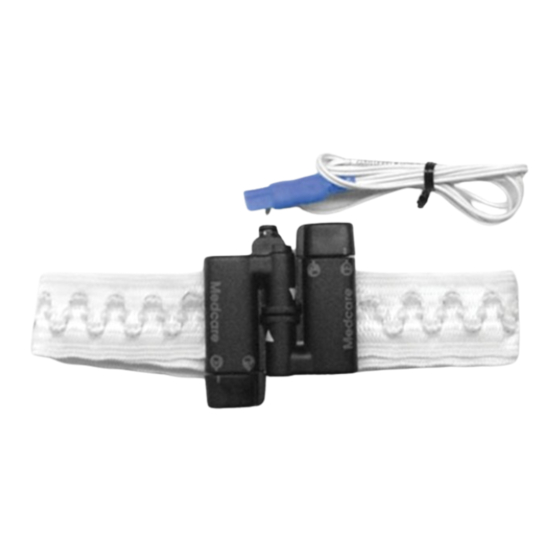
Advertisement
Quick Links
Universal–Single Use XactTrace™
Instructions
The Universal-Single Use XactTrace Respiratory Inductive Plethysmogragh
(RIP) sensor belt is a respiratory effort sensor used in the diagnosis of
sleep disordered breathing. XactTrace measures changes in inductance,
and converts it into a digital signal that gives both qualitative and
quantitative data. This sensor is more sensitive and reliable than typical
respiratory effort sensors, especially in cases of paradoxical breathing.
The Universal-Single Use XactTrace belts consist of a belt roll that can be
cut to appropriate lengths for each patient and two Belt Locks for the
abdomen and thoracic regions.
Fitting the XactTrace Belts
The XactTrace belts must be custom fit for each patient. When using the
XactTrace belts, avoid all unnecessary contact with
moisture.
1. Encircle the belt around the patient's chest
under the arm to approximate the
circumference for the thoracic belt.
2. When cutting the belt, reduce its circumference by 10-15cm (4-6
in) so it stretches around the thorax. The belt should fit snugly to
1
Advertisement

Summary of Contents for Embla XactTrace
- Page 1 This sensor is more sensitive and reliable than typical respiratory effort sensors, especially in cases of paradoxical breathing. The Universal-Single Use XactTrace belts consist of a belt roll that can be cut to appropriate lengths for each patient and two Belt Locks for the abdomen and thoracic regions.
- Page 2 Belt Lock with the yellow connector. Attaching the XactTrace Belts The XactTrace belts are intended to be worn over the patient’s nightclothes. 1. Place the belt with the yellow connector around the patient’s...
- Page 3 Universal–Single Use XactTrace™ Instructions 2. Take the two components of the Belt Lock and connect them, as shown below. 3. Place the second belt with the blue connector around the patient’s chest, under the arm. 4. Connect the second Belt Lock as shown above.
-
Page 4: Cleaning And Disposal
This causes interference between the two sensors, resulting in bad signals. Storage Proper storage of the XactTrace Belt Locks between recordings is important. To protect the sensor cable from damage, do not wrap it tightly around the Belt Lock, as it might cause the cable to break where it connects to the Lock. - Page 5 Connect the XactTrace sensors to an electrically isolated input only. Do not plug the cables into electrical outlets, as this could result in serious electrical shock.
-
Page 6: Technical Specifications
Universal–Single Use XactTrace™ Instructions Single Use – Universal XactTrace User Settings User settings are described below. Sensitivity – Adjustment of the sensitivity up or down is typically required. Response is dependent upon variables, such as sensor application and patient effort. -
Page 7: Warranty
The sole liability of Embla Systems and our distributors is limited to replacement or repair of the product at the option of Embla Systems, with no charge for parts or labor if any part is proven to be defective in workmanship, performance, or materials during the warranty period. - Page 8 All clinical conclusions and decisions that are made based on the use of this product are the responsibility of the user. Embla does not accept any liability or responsibility for damages arising out of the use of or inability to use this product.


Need help?
Do you have a question about the XactTrace and is the answer not in the manual?
Questions and answers